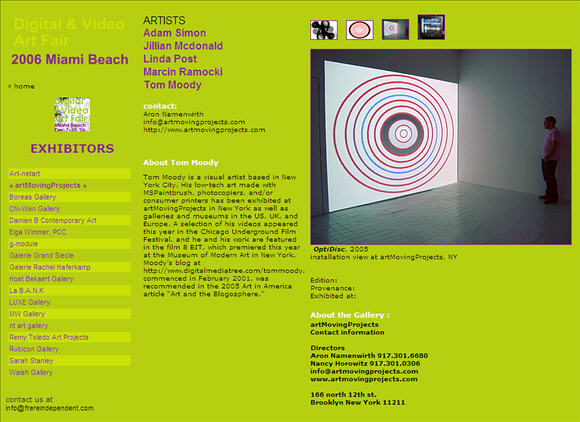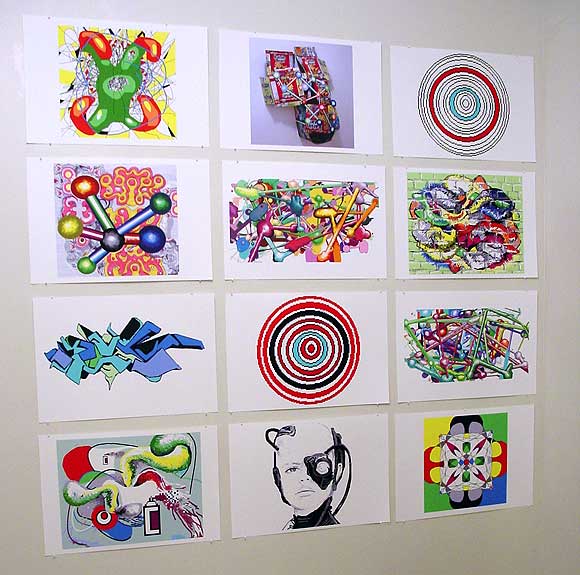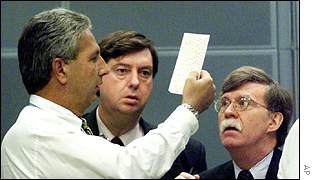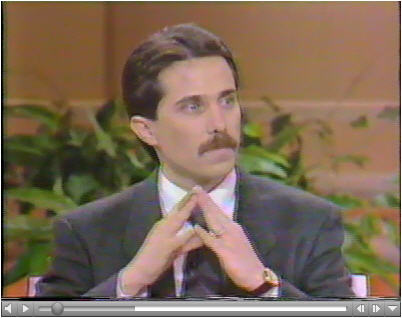View current page
...more recent posts

Someone assumed from a previous post that because I had work at the Digital Art and Video Fair (see above) that I was going to Miami. I AM NOT GOING TO MIAMI. It's bad enough having to see work by artists like Takashi Murakami in NY, much less having to travel to see it.
But, um, I certainly appreciate artMovingProjects taking my work down there so I can stay here in my ivory tower. The DiVa fair is being held in shipping containers on the beach, so a certain aesthetic distance is maintained from the general orgy of commerce. As befits the true vanguard.
1986
"It's My Beat" (Sweet Tee and Jazzy Joyce)
Jazzy Joyce (On the wheels) Jazzy Joyce (No one better)
Jazzy Joyce (Speedin' faster than an '86 Jetta)
Cold blooded terrorizin', baby, that you can bet
(And if you battle me, never let me see you sweat)
Hear it: 250 KB .mp3
1994
"9th Wonder (Blackitolism)" (Digable Planets with Jazzy Joyce)
Jazzy Joyce (On the wheels) Jazzy Joyce (No one’s smoother)
Jazzy Joyce (Phatter than a '94 Land Cruiser)
Where you from? (The Bronx, representin' like whatever fly)
Cool, are you slicker this year? (Yeah, why?)
Hear it: 250 KB .mp3

My criteria for this group of images were everything had to: (i) be printed landscape orientation, 13 x 19 inches, and (ii) have appeared on this blog since the printing of the last group of pictures done in this fashion. All are 100% rag paper, archival ink, blah blah. The grouping is at once an installation, twelve separate drawings (a term I'm stretching to include photography), a physical record of images disseminated online, and a reification of a particular slice of this blog. Some of the content I invented out of whole cloth; some are my interpretations of others' images. Except for changes in scale to fit the paper size, nothing was altered from the way it appeared online. These would be framed for a real-space presentation. Sorry if this sounds stuffy, just trying to nail down my concept.
Spoken word mp3: Interview with Marcin Ramocki and Justin Strawhand about the movie 8 BIT - about 35 minutes long - can be found on the Small World Podcast blog. Begins with a Bill O'Reilly soundbite about evil, pathetic kids "plugged into machines" and proceeds to rebut that nonsense. A good, tuneful Bit Shifter Game Boy music piece at the very end.

John Bolton is resigning after pretending to be UN ambassador for a year--finally! As the photo above reminds us, he was one of the recount cheaters who got Bush "elected" back in 2000. (See those fanatic eyes searching, searching for hanging chads.) He's a Bush loyalist, a hard core right winger, a hack--he should never be in the UN because his kind wants to abolish it.
Good Simon Reynolds post on "the future" in music:
Perhaps there’s a three-way division here.As for "futuroid," the only way you could really evaluate something "unforeheard" would be after it already occurred, so this category is paradoxical and possibly useless for present criticism or music creation. But the 3-way definition is a good way of getting at the differences between what's actually happening that's forward-looking, unexamined retro notions (a la The Jetsons) of what's ahead, and the undefinable something that the future will recognize as avant garde or "ahead of its time." I agree with the statement in his post that early '90s breakbeat hardcore was more revolutionary than what came after, drum and basswise, yet was about musicians trying to top each other with new gear "in the now"--not with some eye cocked on the future.
Futurism
Artists who make an overt ideology out of their aspiration to make tomorrow’s music today (this would include quite a few techno people, but also a group like The Young Gods, or earlier, the Art of Noise--both of whom could also be seen as having a relationship to the actual early 20th Century movement Futurism, adding a tinge of retro-Futurism)
Futuristic
Artists who play with science fiction imagery, a set of signifiers and associations that refer back to a tradition of how the Future was envisaged or sonically imagined. For quite some time--even in the early 90s--this kind of thing already had a retro-futurist tinge to it. Again lots of techno artists went in for this kind of imagery but so did a lot of genres (synthpop, industrial, space music) outside the dance field.
Futuroid
The actually emergent or unforeheard elements in music.
(Why not call this 'modernist'? Well, Modernism is itself a style, a period-bound thing to the point where there is such a thing as retro-modernism... Not all futuroid things are going to manifest as stark/lacking ornament/bleak/brutal/abstract/functional/minimalist, i.e. the cliches of modernism... For instance breakbeat science as it evolved turned into a kind of rhythmic baroque, and wildstyle graffiti, while futuroid and futuristic, was not Modernist in that style-defined sense of stark etc).
To map this onto the old Raymond Williams residual/emergent dichotomy, most musics that are any good or at all enjoyable or have any impact on the wider culture are going to involve a mixture of futuroid and traditional. A wholly Futuroid music would probably be as indigestible as Marinetti’s proposed Italo-Futurist replacement for pasta--a dish of perfumed sand.


Gore Vidal on Film; Javier Morales and John Michael Boling's "The Church of the Future"
From an interview with Gore Vidal in this month's Bookforum:
BF: Your writing career extends to the silver screen, particularly your script for Ben-Hur. You wove in a homoerotic story line that suggested a past romance between Ben-Hur and Messala, but this fact was supposed to be kept secret from Charlton Heston. Was there a thrill in doing that?What Vidal says about film--it's the only art form that "lacks mind"--and the default role of editors in creating that art is a slap at auteur theory but I agree with him in the sense that film is more like painting or music than literature. I thought about his comment when I saw this web video by Javier Morales and John Michael Boling called "The Church of the Future," which assembles a story out of pure televisual vapor. It has no more or less "mind," in the sense of a cognizable rhetorical point, than the Nightly News does--another kind of "film," which we take to be real, but which is a crafted amalgam of clips that may convey messages different than what the producers intended. Yet the "Church" video is profound, in the way its editing choices create a mood of tension and weirdness out of sampled mainstream TV (only the Marilyn Monroe mask wearing businessman--which seems very DEVO/Subgenius/Firesign Theatre--departs from "ordinary."). Some of the big hair reaction shots from a random "televangelical" audience are exquisite portrait photographs.
GV: No, it was necessity. The script just didn't work. I had to explain why on earth they're feuding for four hours. The romantic subtext worked like a dream.
BF: Charlton Heston, of whom you wrote directing him must be like trying "to animate an entire lumberyard," refused to acknowledge your contributions to the script, insisting that the director, William Wyler, rejected your suggestions.
GV: Charlton Heston told lies. I had as little to do with him as possible. He was also the last choice of the director and the producer. They were stuck with him. And then it turned out he wasn't as good as Stephen Boyd, who played the Roman. But that was not my problem. I was not producing it. I was there to try to dramatize an old and rather junky story.
BF: In the new memoir, you say that, in today's culture, "where literature was movies are." Are there films that rank with good literary fiction?
GV: I don't think you could ever compare the two. Literature is where it is and totally different, and movies are a peculiar art form. Film is the only art form that lacks mind, because there's no way the individual writer can supply it with ideas. Directors make their contributions, some better than others. Film editors probably do the most work toward creating what you see up on the screen. And they are working quite separately from whatever the movie may be about. They're just trying to get images straight. It's not a medium you can invest with the sort of ideas that work in a novel or even poetry.
Update: scare quotes added to the word televangelical since we have no idea who this audience is. See comments.
Two early '30s Frank Capra movies on TCM last night I'd not seen--American Madness and the better-known Lady for a Day. The former prefigures It's a Wonderful Life with its honest banker (played by the dynamic Walter Huston) who makes loans based on his personal assessment of a borrower's character, as well as a scary "run on the bank" scene where Huston makes a speech to panicked depositors. An amazing montage of faces and voices showing how the rumor spreads leading to the run (marred by a couple of '30s-obligatory but obnoxious racial caricatures) is insanely fast paced and instills a sense of stomach-churning helplessness in the viewer at not being able to stop this human folly. Regarding the speed of the film generally, Capra's IMDb bio offers this intriguing stylistic analysis:
Capra had become convinced that the mass-experience of watching a motion picture with an audience had the psychological effect in individual audience members of slowing down the pace of a film. A film that during shooting and then when viewed on a movieola editing device and on a small screen in a screening room among a few professionals that had seemed normally paced became sluggish when projected on the big screen. While this could have been the result of the projection process blowing up the actors to such large proportions, Capra ultimately believed it was the effect of mass psychology affecting crowds since he also noticed this "slowing down" phenomenon at ball games and at political conventions. Since American Madness dealt with crowds, he feared that the effect would be magnified.
He decided to boost the pace of the film, during the shooting. He did away with characters' entrances and exits that were a common part of cinematic "grammar" in the early 1930s, a survival of the "photoplays" days. Instead, he "jumped" characters in and out of scenes, and jettisoned the dissolves that were also part of cinematic grammar that typically ended scenes and indicated changes in time or locale so as not to make cutting between scenes seem choppy to the audience. Dialogue was deliberately overlapped, a radical innovation in the early talkies, when actors were instructed to let the other actor finish his or her lines completely before taking up their cue and beginning their own lines, in order to facilitate the editing of the sound-track. What he felt was his greatest innovation was to boost the pacing of the acting in the film by a third by making a scene that would normally play in one minute take only 40 seconds.
When all these innovations were combined in his final cut, it made the movie seemed normally paced on the big screen, though while shooting individual scenes, the pacing had seemed exaggerated. It also gave the film a sense of urgency that befitted the subject of a financial panic and a run on a bank. More importantly, it "kept audience attention riveted to the screen," as he said in his autobiography. Except for "mood pieces," Capra subsequently used these techniques in all his films, and he was amused by critics who commented on the "naturalness" of his direction.
